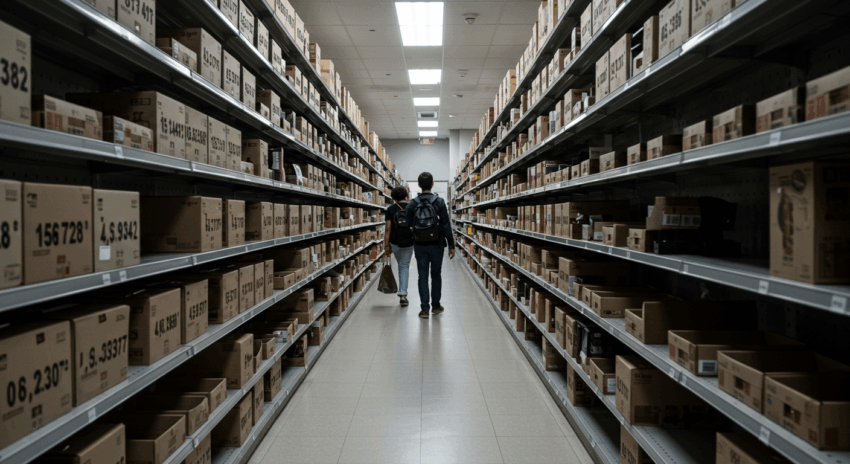The latest US retail sales data has just landed, and it’s sending a significant signal through the financial world. While a report on shopping habits might seem mundane, it’s actually one of the most powerful indicators of the economy’s health. This isn’t just a story for Wall Street traders; it has direct implications for your budget, your savings, and the interest rates you pay. In this article, we will deconstruct these new figures, explore what’s causing this shift in consumer behavior, and explain what it could mean for your personal finances in the months ahead.
Dissecting the Data: A Closer Look at the Numbers
To understand the full picture, we need to look at the hard data. The headline number for April 2024 showed that retail and food services sales were essentially flat, with a 0.0% change from the previous month. This was a significant miss, as economists had widely predicted a modest 0.4% increase. When the market expects growth and gets stagnation instead, it pays attention.
This stall in spending comes after a period of stronger consumer activity, making the sudden stop even more noteworthy. To add more context, the figures for the prior month, March, were also revised downwards from 0.7% to 0.6% growth. This suggests that the slowdown may have already been underway.
Averages can hide important details, so let’s break it down by category:
- Areas of Weakness: The decline was most pronounced in specific sectors. Non-store retailers (a proxy for e-commerce) saw a significant drop of 1.2%. Sales at sporting goods, hobby, musical instrument, and book stores also fell by 0.9%. This hints that consumers are cutting back on discretionary, or non-essential, items.
- Areas of Strength: On the other hand, some areas held up. Gasoline stations saw a 3.1% jump in sales, though this is largely tied to rising gas prices rather than people driving more. Food and beverage stores also saw a modest increase, which is expected as these are essential purchases.
This data paints a clear picture: while people are still spending on necessities, their appetite for “wants” over “needs” is shrinking. This cooling of consumer spending is a critical piece of the economic puzzle.
The ‘Why’ Behind the Wallet-Tightening: Unpacking the Consumer Slowdown
So, why are consumers suddenly holding onto their cash more tightly? It’s not one single reason, but a combination of powerful economic forces that have been building for months.
1. The Persistent Sting of Inflation
While the rate of inflation has been decreasing, prices for many goods and services remain much higher than they were a few years ago. This cumulative effect wears on household budgets. Think of it like this: even if a leaky faucet is dripping slower, the bucket underneath is still getting fuller. Families are feeling the strain of elevated costs for groceries, insurance, and housing, leaving less room for discretionary spending on electronics, new clothes, or dining out.
2. The Heavy Weight of High Interest Rates
The Federal Reserve’s aggressive campaign to fight inflation involved raising interest rates to their highest levels in over two decades. This directly impacts consumers. The cost of borrowing money for major purchases is now much higher. Auto loan rates are steep, and credit card Annual Percentage Rates (APRs) are at record highs. Faced with expensive financing, many potential buyers are delaying purchases of new cars or large appliances, contributing directly to the weaker retail sales figures.

3. Dwindling Pandemic Savings
During the pandemic, government stimulus and reduced spending opportunities allowed many households to build up a significant savings cushion. This excess savings fueled a consumer spending boom for the last couple of years. However, recent data suggests that for a large portion of the population, especially lower and middle-income households, these reserves have been depleted. Without that buffer, people are forced to rely solely on their current income, making them more cautious spenders.
The Ripple Effect: How One Report Shakes the Entire Economy
A single economic report can have far-reaching consequences, influencing everything from central bank policy to global markets. This is particularly true for retail sales, as consumer spending accounts for roughly two-thirds of all US economic activity. This latest report is a crucial part of the broader economy story.
Implications for the Federal Reserve
This is perhaps the most significant consequence. The Federal Reserve (the Fed) has a dual mandate: to maintain price stability (control inflation) and foster maximum employment. For over a year, its primary focus has been on taming inflation. Weak retail sales data is what economists call a “dovish” signal. It suggests that the Fed’s high interest rates are working as intended—they are successfully cooling down demand in the economy, which in turn helps alleviate inflationary pressures.
This development increases the probability that the Fed could begin cutting interest rates later this year. If the economy is slowing, keeping rates high for too long risks tipping it into a recession. Therefore, this data could provide the justification the Fed needs to pivot its policy towards stimulating growth.
Reaction in the Financial Markets
Financial markets reacted almost instantly to the news. Here’s a quick breakdown:
- Stocks: The stock market generally cheered the news. While slowing sales are not good for corporate profits, the prospect of earlier-than-expected interest rate cuts was seen as a larger positive. Lower rates make it cheaper for companies to borrow and invest, and can also make stocks look more attractive compared to bonds.
- Bonds: Bond yields, which move opposite to bond prices, fell. This is a classic reaction. If investors believe the Fed will cut rates in the future, they rush to buy today’s bonds to lock in the current, higher yields, pushing prices up and yields down.
- The US Dollar: The dollar weakened against other major currencies. A currency’s value is often tied to its country’s interest rates. The prospect of lower rates in the US makes holding dollars less attractive to foreign investors, causing its value to decline.
What This Means for Your Personal Finances
For individuals, the implications are tangible. The prospect of lower interest rates is good news if you plan to take out a mortgage, car loan, or personal loan in the next year. It also means the interest rates on your high-yield savings accounts might come down. This is a great time to reassess your financial plan, prioritize paying down high-interest debt like credit cards, and ensure your investment strategy aligns with your long-term goals, rather than reacting to daily market swings.
Frequently Asked Questions (FAQ)
Does this weak retail sales report mean the US is heading for a recession?
Not necessarily. While a slowdown in consumer spending is a key ingredient for a recession, one month of flat data is not enough to confirm a downturn. Economists refer to this as a potential “soft landing,” where the economy cools down enough to control inflation without crashing into a full-blown recession. However, it does increase the risk, and analysts will be watching subsequent data on jobs, inflation, and spending very closely to see if a negative trend develops.
How does this retail sales data affect inflation?
It has an indirect but powerful effect. When consumers spend less, businesses face weaker demand for their products and services. This increased competition for fewer customer dollars makes it much harder for companies to raise prices. In some cases, they may even have to offer discounts to attract buyers. This overall reduction in pricing power across the economy is a key mechanism through which inflation is brought under control.



